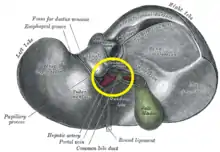Hilum (anatomy)
In human anatomy, the hilum (/ˈhaɪləm/; plural hila), sometimes formerly called a hilus (/ˈhaɪləs/; plural hili), is a depression or fissure where structures such as blood vessels and nerves enter an organ. Examples include:
- Hilum of kidney, admits the renal artery, vein, ureter, and nerves
- Splenic hilum, on the surface of the spleen, admits the splenic artery, vein, lymph vessels, and nerves
- Hilum of lung, a triangular depression where the structures which form the root of the lung enter and leave the viscus
- Hilum of lymph node, the portion of a lymph node where the efferent vessels exit
- Hilus of dentate gyrus, part of hippocampus that contains the mossy cells.

Hilum of the liver.
This article is issued from Wikipedia. The text is licensed under Creative Commons - Attribution - Sharealike. Additional terms may apply for the media files.
